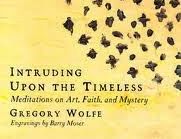Intruding Upon the Timeless (Gregory Wolfe, 2003)

Meditations on Art, Faith & Mystery
For the generation growing up today, within the cultural thrall of postmodernity, it is almost impossible to fully grasp what it means that the world has shifted from a culture of belief to one of unbelief. Even many of us who saw the transition progressing missed its significance. Many of my peers who are believers still talk, for example, as if coming to faith for a young adult today is largely unchanged from their own experience forty years ago. This is one reason a subtle disconnect erodes the space between the local church (which my peers lead) and so many young adults. Faith in an era where disbelief is normative is fundamentally different from faith in an era where belief is normative. The need is not for different content—historic orthodoxy remains orthodox—but for a different context, one brought into authentic tension with the conditions of life under postmodernity. Without listing the reasons why, essential to this necessary context for authentic faith today are biblical categories that were not high on the agendas of Christians of the previous era: mystery, art and creativity, a sanctified imagination.
Gregory Wolfe, founder and editor of Image, describes the loss for the wider culture:
A culture is governed by its reigning myths. There is an increasing sense these days that materialism, whether of the Left or Right, cannot sustain or nourish our common life. Religion and art share the capacity to help us renew our awareness of the ultimate questions: who we are, where we have come from, and where we are going. In their highest forms, religion and art unite faith and reason, grace and nature; they preserve us from the twin errors of superstition and rationalist abstraction. (p. 17)
It was into this cultural context that Image was launched, a quarterly journal dedicated to explore art, faith and mystery. In the opening pages of each issue, Wolfe pens an editorial statement. It is not a summary of the issue’s contents but the brief (1500 words of so) ruminations of a Christian humanist, a believer who is committed to the humanities, to literature and art as an expression of God’s image in humankind. The purpose of the column, Wolfe says, is “to keep the stress on meditation and reflection, to provoke thought rather than to exhaust it,” to provide a “brief impression that opens up space for further thought” (p. 13).
Intruding Upon the Timeless, published by Square Halo Books, collects the first 34 of Wolfe’s editorial statements from Image (along with 17 lovely black & white engravings). The topics range widely: liturgy, Thomas Kinkaid, Flannery O’Connor, the Internet, weaker brethren, Walker Percy, American Beauty, the Eucharist, aesthetics and criticism, and so much more. Scholarly yet accessible, full of a rich network of ideas concerned with what some might say is High Art and Letters, I commend Intruding Upon the Timeless to you. The essays can be read in any order, always reward unhurried reading and reflection, and are brief enough to be read aloud with friends for an evening of discussion and conversation.
Source
Intruding Upon the Timeless: Meditations on Art, Faith, and Mystery by Gregory Wolfe.Engravings by Barry Moser (Baltimore, MD: Square Halo Books; 2003) 168 pages.

